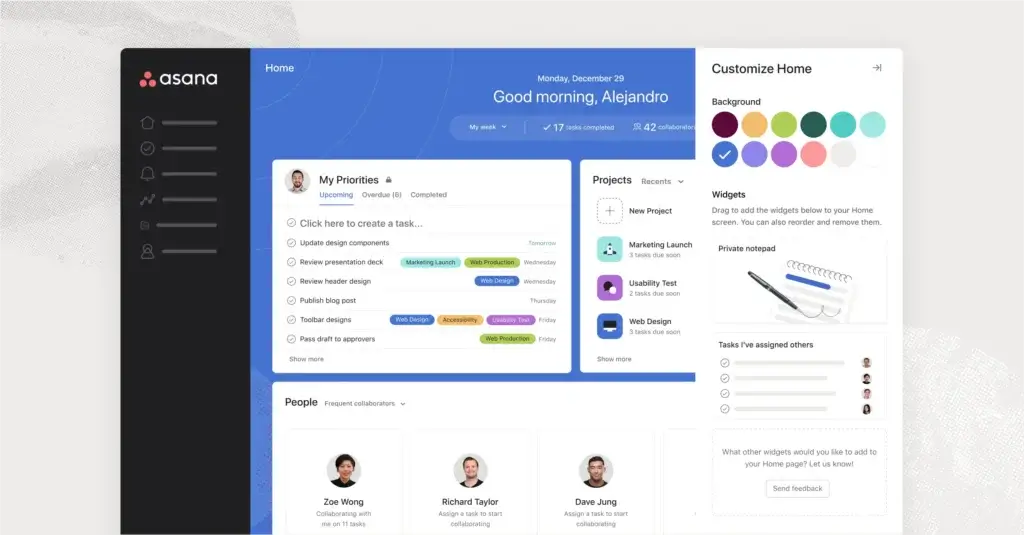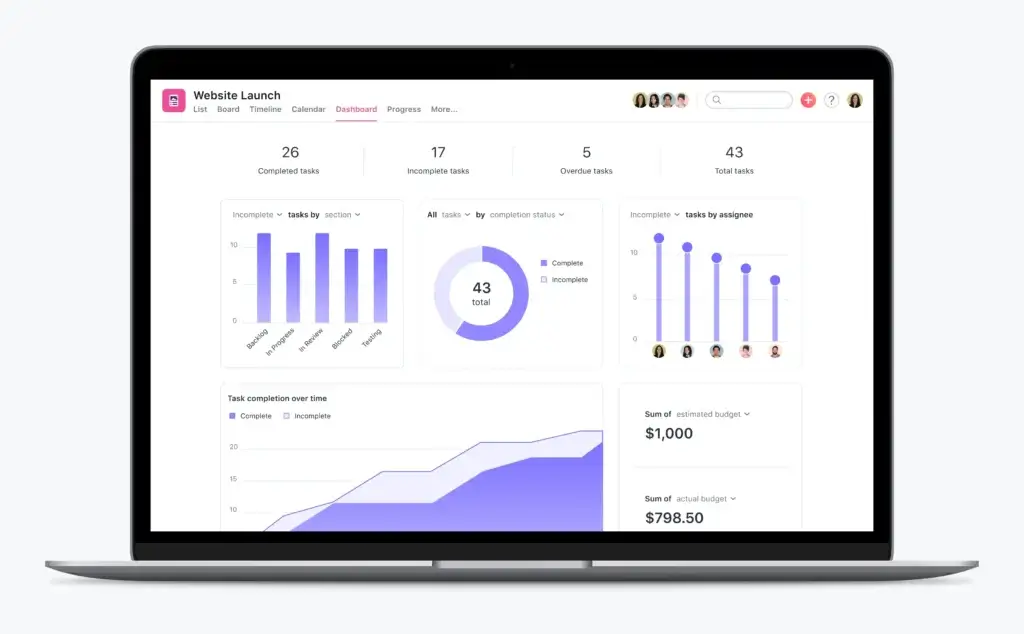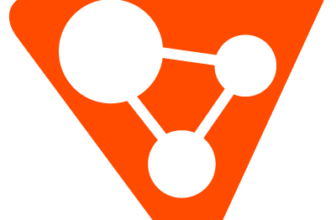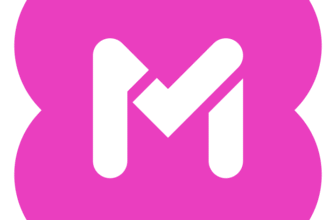Introduction
If you’ve ever struggled with scattered tasks, endless email threads, or missed deadlines, Asana might be the solution you’re looking for. As a cloud-based project management tool, Asana helps teams like yours stay organized, collaborate seamlessly, and keep projects on track, all in one place. Whether you’re juggling multiple projects or managing daily workflows, Asana provides the structure needed to eliminate confusion and boost productivity.
Designed for teams of all sizes and industries, Asana adapts to the way you work. Whether you’re a project manager coordinating deliverables, a marketing team planning campaigns, or a development team tracking sprints, Asana offers the flexibility to fit your needs. Even non-technical teams can easily get started with its intuitive interface, making it a go-to solution for startups, enterprises, and everything in between.
With powerful task management, automation, and integrations, Asana helps you streamline workflows, improve team accountability, and drive better results, without the chaos. Let’s dive deeper into what makes Asana a top choice for modern teams.
Software Specification
Asana’s Core Features
Asana is packed with features designed to simplify project management, enhance team collaboration, and improve workflow efficiency. Whether you’re managing a complex project or day-to-day tasks, Asana provides the tools to keep everything organized. Here’s what makes Asana a powerhouse for teams:
1. Task and Project Management
With Asana, you can create, assign, and track tasks effortlessly. Whether you prefer list views, kanban boards, or calendars, Asana gives you multiple ways to visualize and manage your workload. Set due dates, add priorities, and break work into subtasks to ensure nothing falls through the cracks.
2. Workflow Automation
Repetitive tasks slowing you down? Asana’s automation builder allows you to set up rules that trigger actions, like assigning tasks, updating statuses, or sending reminders, so your team can focus on high-value work instead of manual updates.
3. Collaboration & Communication
No more back-and-forth emails! With task comments, project discussions, and @mentions, Asana keeps communication centralized and transparent. You can also attach files, link to relevant resources, and integrate with tools like Slack for seamless team collaboration.
4. Customizable Project Views
Every team works differently, and Asana adapts to your style. Choose from:
- List View: Organize tasks in a structured to-do list.
- Board View: Use a kanban-style layout for workflow management.
- Timeline View: Plan projects visually with Gantt-style tracking.
- Calendar View: Get a clear picture of deadlines and upcoming milestones.
5. Advanced Reporting & Analytics
Need insights into your team’s progress? Asana offers real-time reporting dashboards, workload monitoring, and productivity tracking, helping you identify bottlenecks and optimize project performance.
6. Integrations with Your Favorite Tools
Asana connects with 200+ apps, including Google Drive, Slack, Zoom, Microsoft Teams, and Jira. This means you can sync your workflows, automate updates, and keep all your work in one place without switching between apps.
7. Goal & OKR Tracking
Keep your team aligned with goal-setting features that link projects to bigger company objectives. This ensures everyone knows what they’re working toward and how their tasks contribute to success.
With these core features, Asana gives you the structure and flexibility needed to manage projects efficiently, improve team collaboration, and hit your goals without the stress.

Pros and Cons
Advantages and Disadvantages
Positive
✅ User-friendly interface
✅ Powerful task management
✅ Automation & integrations
✅ Collaboration tools
Negative
❌ Steep learning curve
❌ Limited features on the free plan
❌ Can get cluttered
❌ Limited Native Time Tracking
Pros:
✔ User-friendly interface – Easy to navigate, even for beginners.
✔ Powerful task management – Assign tasks, set due dates, and track progress effortlessly.
✔ Automation & integrations – Streamline workflows with automation and over 200+ integrations.
✔ Collaboration tools – Keep team communication in one place with comments and mentions.
Cons:
✘ Steep learning curve for advanced features – While basic functionality is easy to grasp, mastering automation and custom workflows takes time.
✘ Limited features on the free plan – Small teams may find the free plan restrictive, especially when scaling.
✘ Can get cluttered – Without a structured approach, too many tasks can create visual clutter.
✘ Limited Native Time Tracking – Asana doesn’t offer built-in time tracking, requiring third-party integrations for teams that need to log hours or monitor billable time.
User Experience
User Interface and Experience
When it comes to project management, a well-designed user interface isn’t just about aesthetics, it directly impacts productivity, ease of use, and overall workflow efficiency. Asana understands this deeply, crafting an experience that balances visual appeal with practical functionality, making it one of the most intuitive tools on the market.
Design Aesthetics: A Visual Experience That Enhances Productivity
Color Scheme & Typography
The first thing you’ll notice when using Asana is its thoughtfully designed color palette. Unlike cluttered or overly rigid interfaces, Asana uses color psychology to enhance usability. Tasks, priorities, and project statuses are color-coded strategically, allowing you to instantly recognize what needs attention.
The typography is crisp, modern, and easy to read, ensuring that important information stands out without straining your eyes. This is especially valuable for teams that spend long hours managing tasks and timelines. Minimalist fonts combined with subtle contrast adjustments help maintain clarity across different screen sizes and devices.
Layout & Spacing: Clean, Clutter-Free, and Efficient
A major strength of Asana’s design is its clean and distraction-free layout. Many project management tools overload users with excessive buttons and menus, but Asana takes a different approach. ample white space, intuitive spacing, and a well-structured hierarchy make navigation seamless.
- Task lists and boards are neatly arranged, preventing visual clutter.
- Consistent alignment and spacing make scanning through projects effortless.
- A balanced use of white space ensures you stay focused on what matters most, your work.
This minimal yet powerful design approach reduces cognitive load, making Asana easier to use without sacrificing depth or capability.
Usability: Designed for Speed, Simplicity, and Efficiency
Intuitive Navigation
Navigating Asana feels natural. The left-hand sidebar provides instant access to projects, tasks, and communication tools, keeping everything just a click away. Instead of wasting time searching for features, you can jump into work instantly.
What makes navigation even better?
✔ Customizable dashboards let you tailor the experience to your workflow.
✔ Consistent icons and labels reduce the learning curve for new users.
✔ Quick-add options allow you to create tasks or projects in seconds.
Seamless Collaboration & Communication
Effective project management requires seamless team communication, and Asana excels here. Task-based comments, real-time updates, and mentions (@) keep everyone on the same page, eliminating the need for long email threads.
Whether you’re updating a project timeline, assigning a task, or providing feedback, Asana ensures that all conversations stay within context, reducing miscommunication and increasing efficiency.
Accessibility: An Inclusive Experience for All Users
Not all project management tools prioritize accessibility, but Asana does. Keyboard shortcuts speed up navigation for power users, while screen reader compatibility ensures that visually impaired users can fully engage with the platform.
Additionally, Asana has introduced:
✔ High-contrast mode for better visibility.
✔ Multiple language support to accommodate global teams.
✔ Mobile-friendly responsiveness, allowing users to manage tasks on the go.
By making the platform universally accessible, Asana ensures that every user, regardless of ability, can benefit from its features.
What Makes Asana’s Interface Stand Out?
The real magic of Asana’s UI lies in its ability to scale with your needs. Whether you’re a solo freelancer managing personal tasks or a large enterprise handling complex workflows, the platform adapts without feeling overwhelming.
✔ Beginner-friendly: Simple enough for new users to get started instantly.
✔ Advanced features built-in: Project dependencies, automation, and timeline views for those who need more power.
✔ Continuous improvements: Regular updates and user-driven enhancements ensure the platform evolves with modern project management needs.

Integrations and Compatibility
How Asana Integrates with Other Software
A great project management tool isn’t just about task tracking; it’s about fitting into your existing workflow. Asana excels in this by offering over 200 integrations with the tools you already use, ensuring a seamless work experience without constantly switching between apps. Whether you’re managing marketing campaigns, software development, or team collaboration, Asana’s integrations help streamline processes and boost productivity.
Top Integrations That Supercharge Your Productivity
1. Communication & Collaboration – Keep Everyone in Sync
✔ Slack – Convert Slack messages into tasks, get Asana updates directly in Slack, and keep conversations actionable.
✔ Microsoft Teams – Create, manage, and track Asana tasks within your Teams workspace for smoother collaboration.
✔ Zoom – Attach meeting recordings and transcripts directly to tasks, ensuring your team never loses important discussions.
2. File Storage & Document Management – Centralize Your Work
✔ Google Drive & Dropbox – Attach documents, spreadsheets, and presentations to tasks without leaving Asana.
✔ OneDrive – Keep project files organized and accessible within your Asana workspace.
3. Development & IT Tools – Streamline Engineering Workflows
✔ Jira – Sync issues and tasks between Asana and Jira, ensuring seamless collaboration between project managers and development teams.
✔ GitHub – Link pull requests and commits directly to Asana tasks to track development progress in real time.
4. Marketing & CRM – Manage Campaigns More Effectively
✔ HubSpot – Align sales and project management by syncing deals and workflows between HubSpot and Asana.
✔ Mailchimp – Plan and track email campaigns within Asana, keeping marketing efforts organized.
5. Automation & Productivity – Eliminate Repetitive Work
✔ Zapier – Automate workflows by connecting Asana with thousands of other apps.
✔ Power Automate – Automate repetitive processes between Microsoft and Asana.
Custom API & Advanced Integrations
For teams needing deeper customization, Asana’s robust API allows businesses to build custom integrations, automate workflows, and connect with proprietary systems. Whether you’re developing internal dashboards or automating task updates, Asana adapts to your tech stack.
Why Asana’s Integrations Matter
✅ Reduce context switching – No need to jump between multiple tools; Asana centralizes your work.
✅ Improve collaboration – Teams using different tools (e.g., developers on Jira, marketers on HubSpot) can still work together seamlessly.
✅ Enhance productivity – Automate repetitive tasks, sync data effortlessly, and ensure smoother workflows.
By integrating with the tools your team already relies on, Asana becomes the central hub for all your work, helping you move faster, stay organized, and get more done. Whether you’re a startup or an enterprise, Asana’s deep integrations ensure that your projects stay on track, no matter what tools you use.
Compare with Others
Alternatives to Asana
Choosing the right project management software depends on your team’s needs. Here’s how Asana stacks up against top competitors like Trello, ClickUp, and Monday.com in key areas:
Easily compare top software
| Feature | Asana | Trello | ClickUp | Monday.com |
| Ease of Use | Intuitive UI, fast setup | Simple, Kanban-focused | Feature-rich but complex | Customizable but requires setup |
| Task Management | Lists, Boards, Timeline, Calendar | Primarily Kanban | Lists, Boards, Docs, Gantt | Boards, Lists, Timelines |
| Automation | Advanced rules, workflow builder | Basic automation with Power-Ups | Powerful automation, custom scripts | Built-in automations, easy setup |
| Collaboration | Task comments, real-time updates | Basic comments, no chat | Docs, chat, real-time editing | Integrated messaging & updates |
| Reporting & Analytics | Custom dashboards, workload tracking | Limited reporting | Strong reporting, goal tracking | Advanced dashboards & analytics |
| Integrations | 200+ integrations (Slack, Jira, Zoom) | Limited Power-Ups | 1,000+ integrations via Zapier | Wide range of direct integrations |
| Best For | Teams needing flexibility & automation | Small teams focused on Kanban | Power users who want deep customization | Companies that prioritize structured workflows |
Which One is Right for You?
- Choose Asana if you want flexibility, automation, and scalability without a steep learning curve.
- Choose Trello (full review) if you prefer simple, visual Kanban boards for lightweight task tracking.
- Choose ClickUp (full review) if you need highly customizable workflows and don’t mind complexity.
- Choose monday.com (full review) if you want structured, visually-driven project tracking with built-in templates.
Read more about the best project management software
Pricing
Free vs Paid
Asana offers a range of plans to suit different team sizes and needs:
-
Personal: Free for individuals and small teams, including unlimited tasks, projects, and messages.
-
Starter: At $10.99 per user/month (billed annually), it adds features like Timeline view, Workflow Builder, and advanced search.
-
Advanced: Priced at $24.99 per user/month (billed annually), it includes Goals, Portfolios, and enhanced automation capabilities.
-
Enterprise: Tailored for large organizations with advanced security and customization needs; pricing is available upon request.
For detailed information, visit Asana’s pricing page.
Here’s a concise comparison table outlining Asana’s pricing plans and key features:
| Feature | Personal | Starter | Advanced | Enterprise |
| Price | Free | $10.99/user/mo | $24.99/user/mo | Custom Pricing |
| Tasks & Projects | ✔️ Unlimited | ✔️ Unlimited | ✔️ Unlimited | ✔️ Unlimited |
| Views | List, Board, Calendar | List, Board, Calendar, Timeline | List, Board, Calendar, Timeline, Workload | All views + advanced reporting |
| Automation | Basic Rules | Custom Rules & Forms | Advanced Automation & Integrations | Enterprise-grade automation |
| Collaboration | Task comments & basic sharing | Private projects & custom fields | Advanced reporting & dashboards | Org-wide collaboration tools |
| Security & Admin | Basic permissions | Admin controls & custom templates | Advanced security & permissions | SAML, SCIM, audit logs, and compliance |
| Integrations | Limited | Standard integrations | Advanced integrations | Enterprise-grade integrations |
| Support | Community support | Standard support | Priority support | Dedicated account manager |
| Best For | Individuals & small teams | Growing teams needing more structure | Businesses requiring advanced tracking & automation | Large enterprises with security needs |
Security and Compliance
What about security?
Asana’s Security & Compliance: Keeping Your Data Safe
When managing projects, security isn’t just an option; it’s a necessity. Asana understands this and provides enterprise-grade security to keep your data protected while ensuring compliance with industry standards.
Robust Data Protection
Asana uses SOC 2 Type II, ISO 27001, and GDPR-compliant security protocols, ensuring your data is encrypted both in transit and at rest. With TLS 1.2+ encryption, your sensitive information stays safe from unauthorized access.
Advanced Access Controls
You’re in control of who sees what. Asana offers role-based permissions, single sign-on (SSO) with Google and Microsoft, and SCIM provisioning to help manage user access securely. Enterprise users get granular admin controls, allowing you to set security policies that align with your organization’s needs.
Compliance & Privacy Standards
Asana meets global compliance requirements, including:
✔ GDPR & CCPA – Protecting user privacy and data rights.
✔ SOC 2 Type II & ISO 27001 – Ensuring enterprise-grade security.
✔ HIPAA (Enterprise plan) – Secure enough for healthcare and regulated industries.
Continuous Monitoring & Incident Response
Security threats evolve, and so does Asana’s defense. With 24/7 monitoring, automated threat detection, and regular third-party audits, Asana ensures a proactive approach to cybersecurity.
Bottom Line: Secure, Compliant, and Trustworthy
Whether you’re handling sensitive business data or managing internal projects, Asana keeps your information protected with cutting-edge security measures. With compliance certifications, encryption, and advanced admin controls, you can focus on work without worrying about security risks.
The Genesis of Asana
The Company and Product Evolution
Asana: A Decade of Innovation in Project Management
Asana was founded in 2008 by Dustin Moskovitz and Justin Rosenstein, former Facebook engineers who saw firsthand the inefficiencies of managing work across teams. Their mission? To build a tool that eliminates busywork, enhances collaboration, and helps teams focus on meaningful work.
Since its official launch in 2012, Asana has grown into a versatile, enterprise-ready work management platform, continually evolving with powerful automation, AI-driven insights, and deep integrations. Here’s how Asana has developed over the years:
Asana’s Evolution: A Timeline of Key Milestones
✔ 2008 – Asana is founded by Dustin Moskovitz and Justin Rosenstein.
✔ 2012 – Public launch of Asana as a task management platform.
✔ 2015 – Introduction of task dependencies, allowing teams to structure workflows more effectively.
✔ 2016 – Launch of Boards (Kanban-style view) for improved visual task tracking.
✔ 2018 – Asana expands globally and introduces Timeline View (Gantt charts) for long-term project planning.
✔ 2020 – Asana goes public (NYSE: ASAN), solidifying its position as a leading project management tool.
✔ 2021 – Introduction of Goals & OKRs tracking, aligning projects with company objectives.
✔ 2023 – AI-powered automation features roll out, enhancing workflow automation and efficiency.
✔ 2024 – Continued improvements in security, reporting, and AI-driven insights, making Asana an all-in-one work management solution.
Where Asana Stands Today
From a simple task management tool to a full-fledged work management system, Asana has continuously evolved to meet the needs of teams across industries. Whether you’re a startup looking for organization or an enterprise needing advanced project tracking, Asana’s commitment to innovation and usability makes it one of the most powerful project management solutions available today.
With its user-friendly interface, automation, and seamless integrations, Asana ensures that your team works smarter, not harder, and continues to evolve to support the future of work.
Conclusion
Final thoughts
Is Asana the Right Project Management Tool for You?
If you’re looking for a powerful yet user-friendly project management tool, Asana is a top contender. With its intuitive interface, automation features, and seamless integrations, it helps teams stay organized, collaborate efficiently, and execute projects with precision. But is it the best fit for you?
Pros & Cons at a Glance
✅ Feature-Rich – From task tracking to workflow automation, Asana scales with your needs.
✅ User-Friendly – Clean, intuitive design that minimizes the learning curve.
✅ Seamless Integrations – Works with 200+ tools to streamline your workflow.
✅ Scalable – Suitable for individuals, startups, and large enterprises alike.
❌ Learning Curve – Advanced features may take time to master.
❌ Pricing – Some of the most powerful tools are locked behind paid plans.
Who Should Use Asana?
🔹 Small Teams & Startups – The free plan offers essential tools for managing tasks without extra costs.
🔹 Growing Businesses – Features like Timeline and Workflow Builder help teams scale efficiently.
🔹 Enterprises – Advanced security, automation, and admin controls support complex workflows.
Final Thoughts
Asana strikes the perfect balance between simplicity and advanced functionality, making it ideal for teams that need both flexibility and power in their project management tool. Whether you’re just starting out or running large-scale operations, Asana adapts to your workflow and grows with your business.
Want to explore more options? Check out our comparison of the best project management tools to find the perfect fit for your team.
For the latest updates, visit Asana’s official website.
Have more questions?
Frequently Asked Questions
1. Can Asana be used for Agile project management?
Yes, Asana supports Agile workflows through features like Boards (Kanban), task dependencies, sprints, and backlog management. While it’s not a specialized Agile tool like Jira, you can easily adapt Asana to Agile, Scrum, or hybrid methodologies with templates and custom fields.
2. Does Asana offer time-tracking features?
Asana does not include built-in time tracking, but it integrates seamlessly with time-tracking tools like Harvest, Everhour, and Clockify. You can also use third-party apps via Zapier or browser extensions to monitor time on tasks.
3. Can you use Asana offline?
Yes, Asana’s mobile apps (iOS and Android) support offline functionality. You can create tasks, update projects, and make comments offline, and your changes will sync automatically once you’re back online. However, the web version does not support offline access.
4. What kind of support does Asana offer?
Asana provides several tiers of support:
-
Free users get access to the knowledge base and community forums.
-
Starter & Advanced plans include standard support.
-
Enterprise clients receive priority support and a dedicated Customer Success Manager.
Support is available via email, help center, and for enterprise accounts, via phone and live chat in some regions.
5. Does Asana have templates for different project types?
Yes, Asana offers hundreds of pre-built templates for project types like marketing campaigns, product launches, HR onboarding, event planning, and software development. You can also create custom templates to match your internal workflows.
6. Is Asana secure for confidential and sensitive projects?
Yes. Asana is built with enterprise-grade security, including data encryption, audit logs, and compliance with SOC 2 Type II, ISO 27001, GDPR, and HIPAA (on Enterprise plan). You can confidently manage projects with sensitive data, including client work or internal operations.
7. Can you use Asana for personal task management?
Absolutely. While Asana is built for teams, the Personal (Free) plan is great for individuals managing personal goals, to-do lists, freelance projects, or side hustles. You can use boards, due dates, reminders, and even recurring tasks.
8. Does Asana support multi-language interfaces?
Yes, Asana is available in several languages, including English, Spanish, French, German, Portuguese, Japanese, and more. This makes it suitable for global teams and users who prefer localized interfaces.
9. What is the Asana Work Graph®?
Asana’s Work Graph® is its proprietary system for connecting every task, project, goal, and team member in a centralized structure. It helps you track relationships and dependencies across your organization, improving clarity and alignment from top-level goals to individual tasks.
10. How does Asana compare to Jira for software teams?
Jira is better suited for technical Agile teams needing granular sprint planning, issue tracking, and version control. Asana, on the other hand, is more versatile and user-friendly, which is ideal for cross-functional teams that need an intuitive, scalable platform for marketing, design, operations, and customer success.








